Bila Tserkva - Overview
Bila Tserkva is a city in Ukraine, a significant economic, cultural and educational center of Kyiv Oblast, as well as a climatic and balneological resort.
Located about 87 km south of Kyiv on the Ros’ River, it is the largest city in the Kyiv region in terms of population. The city of Kyiv is a separate administrative-territorial unit within Ukraine and is not part of the Kyiv region.
The population of Bila Tserkva is about 207,000 (2021), the area - 68 sq. km.
The phone code - +380 456(3), the postal codes - 09100-09117.
History of Bila Tserkva
At the beginning of the 11th century, the nomadic raids on the southern outskirts of Kievan Rus intensified. In 1017, the Prince Yaroslav the Wise defeated the Pechenegs and forced them to move to the south. In 1032, to strengthen the southern borders along the Ros’ River, the construction of a system of guard fortresses began.
One of such fortresses was named St. Georgiy on Ros or simply Georgiy (Yuryev) (in honor of the Christian name of Yaroslav the Wise). The heart of the new settlement was a mountain with a castle and a white-stone cathedral on it.
The town was repeatedly attacked and destroyed by various nomads: Pechenegs, Polovtsy, Mongols. The last time Yuryev was devastated and burned by nomads in the 13th century. The only remaining building was a large dilapidated cathedral. Built of white stone, it served as a landmark among the local dense forests.
Therefore, a new settlement, which rose from the ruins of Yuryev, was named Bila Tserkva meaning “White Church”. During the archaeological excavations conducted in the 20th century, the remains of the church were found on the Castle Hill.
More Historical Facts…
In 1362, Bila Tserkva, together with the Kyiv Principality, was annexed to Lithuania, and after the Lublin Union (1569) it became part of the Polish-Lithuanian Commonwealth. The town became an important strategic point in the south of the country. In 1589, the Polish King Sigismund III approved the privileges of the town at the Sejm in Warsaw, giving it and its inhabitants Magdeburg law.
In the middle of the 16th century, a castle was built to protect the town from the next iteration of nomads (the Crimean Tatars). There was a permanent Polish garrison numbering up to 2,000 soldiers and officers. Bila Tserkva played the role of one of the most important centers of the first Cossack wars of the end of the 16th century.
During the Khmelnytsky Uprising (the Cossack-Polish War) of 1648-1657, Bila Tserkva became one of the most important strongholds of the Cossack army. Bohdan Khmelnytsky with his main forces was stationed in this castle.
Since 1660, Bila Tserkva alternately belonged to the Tsardom of Russia and the Polish-Lithuanian Commonwealth. The beginning of the 18th century was again marked by a large uprising of the Cossacks leaded by Semen Paliy. Bila Tserkva became its center.
In 1774, Bila Tserkva was presented to the crown hetman Franciszek Ksawery Branicki. The town was in the possession the Branicki family until 1917. In 1793, the town was annexed to the Russian Empire as a result of the Partition of Poland. Bila Tserkva lost its administrative significance, the castle was dismantled.
In 1806, Braniccy signed an agreement with the Jewish community, which was allowed to settle and build in the town. In 1809-1814, shopping arcades were opened in the center, which stimulated the further settlement of Jews in Bila Tserkva and caused a change in the ethnic composition of the local population.
In the 19th century, Bila Tserkva became a significant political and economic center of the region. The Branicki residence was being visited by emperors and members of the royal family, prominent Russian and Polish political figures. In 1918, this town played a leading role in the creation of the Ukrainian People’s Republic. For more than a month it was de facto the second capital of Ukraine.
In 1939, the population of Bila Tserkva was about 45 thousand people. July 16, 1941, the town was occupied by German troops. It was liberated by Soviet troops on January 4, 1944. As a result of fierce fighting, Bila Tserkva was almost completely destroyed. Before the war, the Jews accounted for about 20% of the population. Almost all of them were killed during the occupation.
In 1959-1965, 14 new enterprises were built and put into operation; construction of Belotserkovsky Tire Plant, a giant of the petrochemical industry of the USSR, was started. In 1972, the plant was opened and the city turned into an industrial center, one of the most powerful centers of the chemical industry of the Ukrainian SSR. Today, the plant is called ROSAVA and it is the largest manufacturer of tyres in Ukraine.
In the 1970s, the population of Bila Tserkva began to grow rapidly - in two decades it increased by almost 100,000 people. After the Chernobyl disaster, more than 1,700 people from the exclusion zone moved to this city.
Bila Tserkva streets
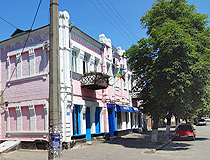
On the street in Bila Tserkva
Author: Stephan White
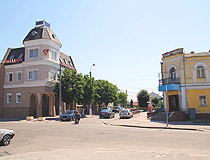
Bila Tserkva street view
Author: Stephan White
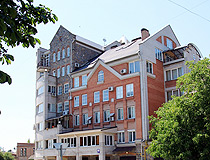
Bila Tserkva architecture
Author: Stephan White
Bila Tserkva - Features
Bila Tserkva, located in the south-west of the Kyiv region, occupies an advantageous geographical position. Next to it there is the E95 highway (St. Petersburg - Kyiv - Odessa). The distance to the Boryspil International Airport is about 120 km.
The proximity to Kyiv, convenient transport links, developed social and economic infrastructure combined with landscape and natural conditions give this city a significant investment and tourist potential. It is also the largest cultural center of the region.
In the city there are a lot of small squares and parks located in the historical center. The largest and oldest arboretum in Ukraine is located here - Oleksandriya, one of the largest monuments of landscape art of Eastern Europe founded in the late 18th century.
The climate is moderately continental, warm. Winters are mild, the average temperature in January is plus 0.5 degrees Celsius. Summers are warm, the average temperature in July is plus 22.8 degrees Celsius.
The economy of Bila Tserkva is represented by a powerful industrial complex, which consists of more than 50 enterprises. The leading branches are the chemical and petrochemical industry, engineering, mining, light, food, processing, pharmaceutical industries, furniture production.
Main Attractions of Bila Tserkva
Park “Oleksandriya” (1793) - an arboretum founded by the Crown Prince Hetman of Poland Franciszek Ksawery Branicki and named in honor of his wife. The park occupies more than 200 hectares; it has 25 reservoirs, about 2,500 species of plants including plants from South America, China, Japan.
It is one of the oldest and most interesting monuments of landscape art in Ukraine and the main attraction of Bila Tserkva. Opening hours: 08:00-19:00 (Oleksandriya Park Museum: 09:00-17:00, day off - Tuesday).
Shopping Arcade (BrUM) (1809-1814) - a monument of architecture built by Count Branicki in the style of early classicism. The name “BrUM” stands for “Branicki Universalny Magazin” (“Branicki Department Store”). Its opening stimulated trade in Bila Tserkva and contributed to the development of the local Jewish community. There are still small shops and a cafe here, various festivals and cultural events are held on this territory. Torhova Square.
Branicki Winter Palace (1796). This two-story building constructed in the style of classicism, a monument of architecture, was the winter residence of the Branicki family in Bila Tserkva, during summers they lived in a country palace in the park “Oleksandriya”. Today, this building houses the Bila Tserkva School of Arts. 50-richchya Peremohy Boulevard, 13.
Old Water Mill - a monument of architecture of the 19th century. It is a complex of mill buildings and a river dam. From here you can enjoy picturesque views of the Ros’ River and the Church of St. Mary Magdalene. Zamkova Street, 37.
Old Post Station (1825-1833). The complex of post station facilities appeared in Bila Tserkva when the regular communication between Moscow and Odessa was established. The architectural integrity of the complex has been preserved. Also there is a cafe. 50-richchya Peremohy Boulevard, 41-45.
Taras Shevchenko Park - a park of culture and recreation located in the center of Bila Tserkva. For children there is an amusement park. Various city events are held regularly here.
Bila Tserkva Museum of Local History. This museum has collections of items of material and spiritual culture of the south of the Kyiv region. The building of the museum was constructed in the style of constructivism on Zamkova Hill. The numismatic collection has Roman coins, Kyiv hryvnia, money of the Cossack era.
The department of art has icons, paintings and sculptures of the 17th-20th centuries. The monument to Yaroslav the Wise and a city observation point are located nearby. Soborna Square, 4. Opening hours: 10:00-17:30. Day off: Wednesday.
Bila Tserkva sights

Former Choral Synagogue in Bila Tserkva
Author: Stephan White

Tank T-34 in Bila Tserkva
Author: Vadim Dranik
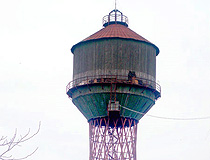
Old water tower in Bila Tserkva
Author: Andrew Niukin
Catholic Church of St. John the Baptist (1812-1813). This church was built by Count K. Branicki on Zamkova (Castle) Hill in memory of his son Alexander, who died in childhood.
In 1990, an organ made by the Czech firm Rieger-Kloss was installed here. Today, the building is used as the Bila Tserkva House of Organ and Chamber Music that can accommodate 300 people. Druzhby Street, 4. Concerts: Saturday, Sunday - 18:00.
Savior Transfiguration Cathedral (1833-1839) - the main Orthodox church of Bila Tserkva located in the center of the city, a vivid example of the transition in church architecture from baroque forms to classicism. The height of the building is 40 meters. Haharina Street, 10.
Church of St. Mary Magdalene (1843) - the only church built outside the historic center of Bila Tserkva in the classical style. During the Soviet era, it was one of the few active churches in the city. Shkil’na Street, 11/16.
Church of St. George the Victorious (2013). This church on Zamkova (Castle) Hill in Bila Tserkva was restored almost at the same place where Prince Yaroslav the Wise laid the first church and fortress of the town of Yuryev in 1032. Nearby there is a monument to Yaroslav the Wise. Druzhby Street, 6.
Choral Synagogue. It was built in eclectic style with the funds of the Jewish community of Bila Tserkva in the 19th century. In the Soviet times, the synagogue was closed. Today, the building belongs to the Technological and Economic College of the Bila Tserkva National Agricultural University. Teatral’na Street, 2/21.


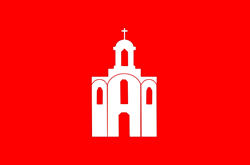







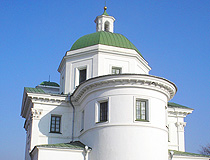
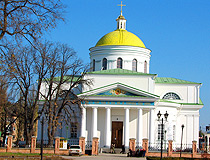
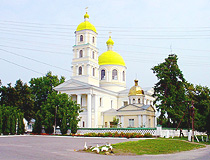
The comments of our visitors